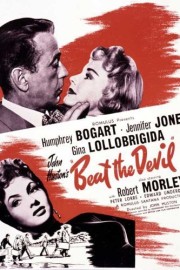Beat the Devil
By the time he made “Beat the Devil,” John Huston was already a legendary director thanks to superb films such as “The Maltese Falcon,” “Key Largo,” “The African Queen,” and “The Treasure of the Sierra Madre.” He would continue in bringing ambitious projects to the screen with films such as “Moby Dick,” “The Bible,” and “The Dead,” based on a short story by James Joyce. As it ended up, “Beat the Devil” appears to be something of an anomaly, even though it features Humphrey Bogart, Jennifer Jones, and Peter Lorre in its cast, and a screenplay (based on a book by James Helvick, actually Claud Cockburn) by Huston and a 28-year-oldTruman Capote, who hadn’t yet written his best known work, In Cold Blood, but was still well known. Hell, when I blind bought the film on DVD several years ago, it was $1.99 on a copyright-free edition; how many films with this caliber of talent fall to such a fate? (Not a word out of Orson Welles’s “The Trial.”) But watching the film, it’s very much of a piece with Huston’s career leading up it. It’s part film noir, part romantic drama, part character comedy, and completely engaging and entertaining. I don’t know that I would label it as a “Great Movie,” as the late Roger Ebert did, but reading his words, and watching the film myself, I understand where he’s coming from, even if I don’t entirely agree with it.
“Beat the Devil” has a story about a cast of characters killing time in an Italian seaport town before they ship off to British East Africa. All of them are looking to get in on a uranium find, but all have their own plans for making themselves wealthy. The plot about the uranium is incidental, however, as the interactions between the characters are more important. Most important is the relationship that builds between Billy (Bogart’s character) and Gwendolen (Jones). They’re both in romantic relationships before meeting– Billy with Maria (Gina Lollobrigida, making her first English-language film), Gwendolen with Harry (Edward Underdown) –but they’re drawn to one another almost immediately. That’s going to make things complicated once all of them are at sea, but not nearly as complicated as it is when government officials realize all of them have plans for this uranium find, which will swindle the British government out of millions if any of their plans work.
At some point, it’s hard to build much interest in the uranium plot, mainly because what really keeps us watching is the way the characters act together. In that way, Huston not only seems to be poking fun at the film noir genre he helped define with movies such as “Falcon” and “Key Largo,” but also pointing the way to something like the Coen Brothers’s “The Big Lebowski,” which also put it’s own spin on the classic noir tradition by making it’s protagonist a truly lazy man. In fact, “Lebowski” seems like the easiest comparison to make when trying to explain “Beat the Devil” to people, and a big part of that is Capote’s acerbic voice as a writer. If this were a straight noir, I can imagine this being relatively dull, and I think Huston and Bogart (who put in some of his own money to get the film made) understood that. By this point, actor and director had already solidified their status as one of Hollywood’s greatest pairings, and Bogart only had a few years left in his life, so they had plenty of goodwill with which to cut loose, and have fun. And the film is definitely fun, because let’s face it, Huston, Bogart, and the rest of the cast (especially Lorre, Jones, and Lollobrigida) are too good to make a dull movie together, especially with characters like this to work with. Don’t get caught up with who, if anybody, will stake claim to the uranium, though, and just sit back and enjoy watching some of Hollywood’s biggest names have a good time. It’s not particularly great cinema, but there’s definitely a sharp wit and love of the material that permeates through everybody on, and off, camera that’s hard to resist.










